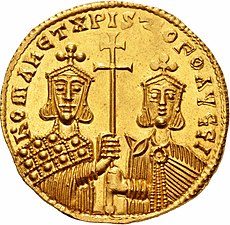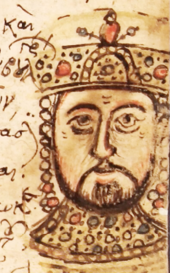Christopher Lekapenos
| Christopher Lekapenos | |
|---|---|
| Emperor of the Romans | |
 Gold solidus of Romanos I Lekapenos (left) with his son Christopher (right) | |
| Byzantine co-emperor | |
| Reign | 20 May 921 – August 931 |
| Coronation | 20 May 921 |
| Predecessors | Constantine VII Romanos I |
| Successors | Romanos I Constantine VII Constantine Stephen |
| Co-emperors | See list
|
| Born | c. 890–895 |
| Died | August 931 (aged c. 35/40) |
| Spouse | Sophia |
| Issue more... | Irene, Empress of Bulgaria |
| Dynasty | Lekapenos |
| Father | Romanos I Lekapenos |
| Mother | Theodora |
Christopher Lekapenos or Lecapenus (Greek: Χριστόφορος Λακαπηνός, romanized: Christóphoros Lakapenōs) was the eldest son of Emperor Romanos I Lekapenos (r. 920–944) and co-emperor of the Byzantine Empire from 921 until his death in 931. Christopher was given the position of megas hetaireiarches (commander of the palace guard) in spring 919, after Romanos assumed guardianship of the underage Emperor Constantine VII. Romanos, who had made himself emperor in 920, raised Christopher to co-emperor on 21 May 921 in order to give his family precedence over Constantine VII's Macedonian line. In 928 Christopher's father-in-law, Niketas, unsuccessfully attempted to incite Christopher to usurp his father, resulting in Niketas being banished. Christopher died in August 931, succeeded by his father and two brothers, Stephen Lekapenos and Constantine Lekapenos, and Constantine VII. In December 944 his brothers overthrew and exiled their father, but they themselves were exiled after attempting to oust Constantine VII.
Life
[edit]
Christopher was the eldest son and the second-oldest child (after his sister Helena) of Romanos Lekapenos and his wife Theodora. His younger siblings were Agatha, who married Romanos Argyros; Stephen and Constantine (co-emperors from 924 until 945); Theophylact (Patriarch of Constantinople in 933–956); and two unnamed younger sisters.[2][3] Nothing is known of Christopher's early life. He was certainly an adult by 919–920, and had a daughter of marriageable age in 927,[4] hence he was probably born around 890–895. Before his father had taken the throne, he had married Sophia, the daughter of Niketas, a wealthy Slav from the Peloponnese who held the high court rank of patrikios.[5]
Romanos succeeded in having his daughter Helena Lekapene married to the 13-year-old emperor Constantine VII Porphyrogennetos in spring 919 and assumed the role of guardian of the emperor with the title basileopator. Christopher succeeded him in his post as megas hetaireiarches, commander of the palace guard.[6][7] Romanos soon crowned himself emperor in December 920, and eventually advanced himself before the young Constantine in precedence. Romanos crowned his wife, Theodora, as augusta on 6 January 921.[8] To further cement his position, and planning to advance his own family over the Macedonian line to which Constantine VII belonged, Romanos crowned Christopher as co-emperor on 20 May 921,[3][4][7][9] When Christopher's mother, Theodora, died on 20 February 922, his wife Sophia was raised to the dignity of augusta alongside Helena Lekapene.[3][10][8] Some solidi dating from Christopher's time as emperor depict him bearded, which the numismatist Philip Grierson describes was "...presumably from a wish to conciliate the formal precedence of Constantine [Porphyrogennetos] with Christopher's greater age and Romanus' desire to favor his own son."[11] Other coins exclude Constantine altogether, instead showing only Romanos and Christopher; on these issues, Christopher appears beardless and smaller than his father.[12]
In 924, Christopher's younger brothers Stephen and Constantine were crowned as co-emperors.[13][14] The popular historian John Julius Norwich comments that the two were immoral and corrupt, and summarises them as "worthless". He states that Christopher, in comparison, "showed some degree of promise and might have proved worthy of his father had he lived to succeed him".[15] On 8 October 927,[3] as part of a peace agreement, Christopher's daughter Maria, renamed Irene (meaning "peace") for the occasion,[13] was married to the Bulgarian emperor Peter I (r. 927–969).[16] The marriage of a Byzantine princess to a foreign ruler was highly unusual at the time.[4][7][17] On the third day of the feast, 10 October, held in Pegae, at the insistence of the Bulgarians, perhaps engineered by Romanos, Christopher was advanced before Constantine Porphyrogennetos, making him first among the rather large group of co-emperors.[3][4][7][17]
In 928, his father-in-law Niketas unsuccessfully tried to incite Christopher to depose his father, but was banished.[3][7][18] The motive behind the attempted coup was perhaps Christopher's poor health, and fears by his wife and her father that, should he die prematurely, they would lose their status.[7][18] In 929, or later, Christopher served as a best man for the wedding of the Bulgarian prince Ivan, who had fled from Bulgaria to Constantinople after conspiring to seize the Bulgarian throne.[3][19] Christopher died in August 931. As Romanos' favourite son, he was much mourned by his father, who shed tears "more than the Egyptians" according to Theophanes Continuatus, and thereafter increasingly became devoted to religious pursuits. Soon after Christopher's death, Sophia too retired from the court and entered a monastery, where she died.[20][21] Christopher's death resulted in the weakening of the alliance between the Byzantine and Bulgarian empires. Irene, the Empress of Bulgaria, ceased making her frequent visits to her homeland in the years following her father's passing, only returning once more.[20]
Christopher was succeeded by his father and his two brothers, Stephen Lekapenos and Constantine Lekapenos, and Constantine VII. In December 944 Stephen and Constantine deposed their father, forcing him to live in a monastery on Prote, in the Princes' Islands, but when they attempted to also depose Constantine VII, the people of Constantinople revolted and overthrew them, resulting in them being likewise exiled. Romanos died in June 948, Stephen on Easter 963, and Constantine sometime between 946 and 948, while trying to escape.[22]
Family
[edit]Through his marriage to Sophia, Christopher had three children:[2][20]
- Maria-Irene, the Empress-consort of Peter I of Bulgaria.[16][23]
- Romanos, still a child at the time of Christopher's death. According to the chronicler Zonaras, he was favoured by his grandfather, who considered promoting him to his father's place as senior co-emperor, which ultimately failed due to his death shortly after his father's.[20]
- Michael, an infant at the time of Christopher's death, was made a cleric at the time of the family's fall from power in 945. He eventually reached the high dignities of magistros and rhaiktor, both high-ranking positions at the Byzantine court, but nothing further is known of his later life.[2][24]
References
[edit]- ^ Gratziou 1997, pp. 39–62 (48).
- ^ a b c Kazhdan 1991, p. 1204.
- ^ a b c d e f g PmbZ, Christophoros Lakapenos #21275.
- ^ a b c d Grierson & Bellinger 1973, p. 528.
- ^ Runciman 1988, p. 64.
- ^ Runciman 1988, p. 60.
- ^ a b c d e f Kazhdan 1991, p. 442.
- ^ a b PmbZ, Theodora #27602.
- ^ Runciman 1988, pp. 65–66.
- ^ Runciman 1988, p. 67.
- ^ Grierson & Bellinger 1973, p. 530.
- ^ Grierson & Bellinger 1973, p. 534.
- ^ a b Kazhdan 1991, p. 1639.
- ^ Ostrogorsky 1957, p. 270.
- ^ Norwich 1992, p. 156.
- ^ a b Previté-Orton 1975, p. 256.
- ^ a b Runciman 1988, pp. 67, 97.
- ^ a b Runciman 1988, pp. 71–72.
- ^ Runciman 1930, pp. 187–188.
- ^ a b c d Runciman 1988, p. 78.
- ^ Grierson & Bellinger 1973, p. 526.
- ^ Runciman 1988, pp. 234–236.
- ^ Runciman 1988, pp. 78, 237.
- ^ Runciman 1988, pp. 78, 234.
Sources
[edit]- Gratziou, Olga (1997). "Evidence on the Users of the Zonaras Codex at Modena". Δελτίον της Χριστιανικής Αρχαιολογικής Εταιρείας (in Greek). 19 (5–6). doi:10.12681/dchae.1162. ISSN 2241-2190.
- Grierson, Philip; Bellinger, Alfred Raymond, eds. (1973). Catalogue of the Byzantine Coins in the Dumbarton Oaks Collection and in the Whittemore Collection, vol. 3: Leo III to Nicephorus III, 717–1081. Harvard University Press. ISBN 978-0-88402-045-5.
- Kazhdan, Alexander, ed. (1991). Oxford Dictionary of Byzantium. Oxford: Oxford University Press. ISBN 978-0-19-504652-6.
- Lilie, Ralph-Johannes; Ludwig, Claudia; Pratsch, Thomas; Zielke, Beate (1998–2013). Prosopographie der mittelbyzantinischen Zeit (in German). Berlin and Boston: De Gruyter.
- Norwich, John Julius (1992). Byzantium: The Apogee. New York: Alfred A. Knopf. ISBN 978-0-394-53779-5.
- Ostrogorsky, George (1957). History of the Byzantine State. New Brunswick, New Jersey: Rutgers University Press. ISBN 0-8135-0599-2.
- Previté-Orton, Charles (1975). Cambridge Medieval History, Shorter: Volume 1, The Later Roman Empire to the Twelfth Century (1 ed.). Cambridge University Press. ISBN 0-521-09976-5.
- Runciman, Steven (1930). "Emperor of the Bulgars and the Romans". A history of the First Bulgarian Empire. London: George Bell & Sons. OCLC 832687.
- Runciman, Steven (1988) [1929]. The Emperor Romanus Lecapenus and His Reign: A Study of Tenth-Century Byzantium. Cambridge: Cambridge University Press. ISBN 978-0-521-35722-7.
